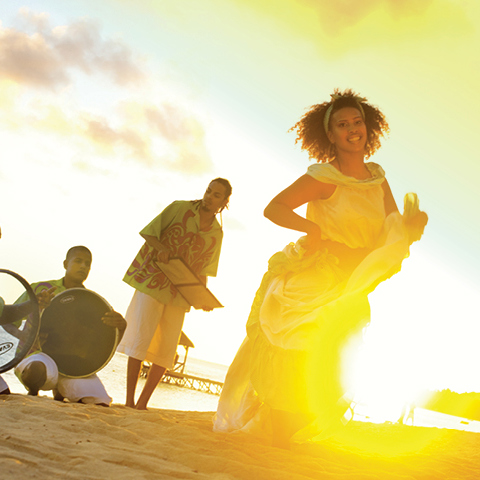
Mauritian Sega
Unlike the notably stylized and systematized movements of Thailand, Mauritian folk dance, known as Sega, is more of a soul-inspired form of expressionism and was traditionally highly sexualized. Historic records suggest that Sega was born of exiled slaves brought to Mauritius by the French from Madagascar, West and East Africa in the 1820s.
Sega offers a specific combination of dancing and singing, a type of courtship drama depicting energetic “play” (the Bantu verbal root of sega) between potential lovers. It is assumed that sexuality and Sega co-mingle because of the associations between dance and fertility rites in many parts of Africa.
The original village dances involved suggestive moves - and it's speculated that the copious amounts of rum consumed by the dancers and crowds alike, in addition to the anticipated climax of the drum riffs, factored into the provocative and pronounced sexual tension between the dancers. Yet, as with most traditional arts, the Sega has mutated to a more tame presentation for many reasons, including increased tourism to the islands. In other words, Sega has been made acceptable for all ages and is now performed at many of the resorts, including Outrigger Mauritius Beach Resort.
The instruments that accompanied the original Sega were simplistic in nature, consisting of goatskin drums with bells attached, coconut shells or wooden boxes with seeds inside and metal triangles or pots with utensils. Although some of these are used in current performances, most have been modernized and now even include a keyboard. The sounds and movements have been quite polished through time and have even melded with Reggae to create what is now referred to as “Seggae.
Likewise, the language of the dance has transmuted over the years. The original languages of the slaves varied, of course, from country and region. Yet, because these people were transported by the French, a Creole language was formed—a type of broken French combined with words from all cultures and used in the singing portion of Sega. Today, however, Sega is sung in multiple languages other than Creole and, in general, both song and dance have been reduced from 15 minutes to five. It has been said that this time reduction is related to modern attention spans. But, perhaps more accurately, the Mauritians are eager to share this unique dance with wider audiences. Hybrid creations are already underway and being performed elsewhere, especially in England and France.